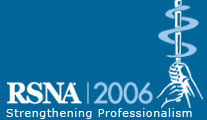
Abstract Archives of the RSNA, 2006
SSQ05-09
Pulmonary MR Perfusion at 3.0 Tesla Using a Blood Pool Contrast Agent: Initial Results in a Swine Model
Scientific Papers
Presented on November 30, 2006
Presented as part of SSQ05: Chest (MR Imaging)
Kambiz Nael MD, Abstract Co-Author: Nothing to Disclose
Roya S. Saleh MD, Presenter: Nothing to Disclose
Carissa Grace Fonseca, Abstract Co-Author: Nothing to Disclose
Hanns-Joachim Weinmann PhD, Abstract Co-Author: Employee, Schering AG
Gerhard Laub MD, Abstract Co-Author: Employee, Siemens AG
John Paul Finn MD, Abstract Co-Author: Consultant, Siemens AG
To prospectively evaluate the technical feasibility of a pulmonary MR perfusion protocol at 3.0T with highly accelerated parallel acquisition using a blood pool contrast agent in a swine model.
12 domestic pigs underwent time-resolved pulmonary MR angiography on a 3.0T MR system, under anesthesia and controlled mechanical ventilation. After intravenous injection of 0.05mmol/kg of Gadomer-17 (Schering, AG, Germany) at 4ml/s, a time-resolved sequence (TR/TE:2.2/1ms, FA:18°, bandwidth: 1120Hz/pixel) with temporal echo-sharing (3 segmented k-space) and generalized autocalibrating partially parallel acquisitions (GRAPPA) with an acceleration factor of 3 was applied. These settings resulted in acquisition of 3D datasets with in-plane resolution of 1 x 1 mm² and temporal resolution of 1s. The image quality (scale 1-3, in which 3 was excellent) was evaluated independently by 2 radiologists and quantitative analysis of perfusion parameters was performed using a perfusion software.
Parenchymal enhancement was identified in all subjects with good image quality (range; 2-3, median: 3) by both readers with an excellent interobserver agreement (к =0.89; 95% CI: 0.83, 0.95). Quantitative analysis of perfusion indices was performed successfully with excellent overall value for goodness-of-fit (p= 0.97, 95% CI: 0.93, 0.99). Perfusion analysis yielded dynamic information including time to peak (TTP): 5.1 ± 0.7, mean transit time (MTT): 6.6 ± 0.9, maximal signal intensity (MSI): 1051.2 ± 718.9 A.U, and maximal upslope of the curve (MUS): 375.9 ± 263.4 A.U/s.
3.0T pulmonary MR perfusion, using a blood pool contrast agent in a swine model is feasible. The available SNR at 3.0T combined with the high T1 relaxivity of Gadomer-17, supports highly accelerated parallel acquisition for high temporal (1s) and spatial (in plane: 1 x 1mm²) resolution datasets, with accurate measurement of perfusion indices.
Combination of 3.0T and blood pool contrast agent with higher T1 relaxivity support fast parallel acquisition technique to further improve the performance of pulmonary time resolved MRA applications.
Nael, K,
Saleh, R,
Fonseca, C,
Weinmann, H,
Laub, G,
Finn, J,
Pulmonary MR Perfusion at 3.0 Tesla Using a Blood Pool Contrast Agent: Initial Results in a Swine Model. Radiological Society of North America 2006 Scientific Assembly and Annual Meeting, November 26 - December 1, 2006 ,Chicago IL.
http://archive.rsna.org/2006/4429771.html

